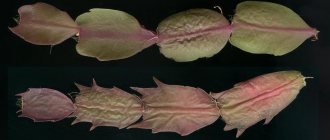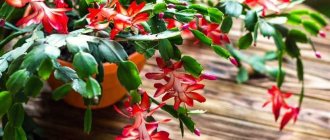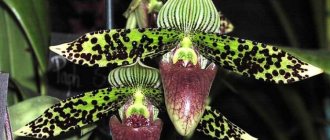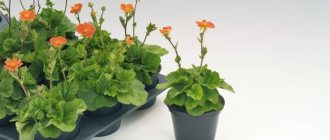When winter comes into its own and there is bitter frost outside, an unusual cactus that does not have needles blooms on the windowsills of many houses. Beautiful flowers appear at the ends of its dark green shoots once a year. Caring for this plant is simple, but it differs from caring for other types of cacti.
For a zygocactus to appear in your collection, you don’t have to go to the store to buy it. To do this, you need to have material suitable for propagation, which can be taken from friends or relatives, and follow simple planting rules. In this article we will tell you how to plant the Decembrist flower correctly.
You may be interested in: Nootka cypress: varieties, description, photo
Zygocactus (Decembrist, Schlumbergera): description and characteristics of the plant
This is an unusual forest cactus that grows naturally on tree trunks in the tropics. The root system of the plant is not resistant to various unfavorable factors, this can cause the death of the plant. With proper care at home, zygocactus blooms in November and this process ends in February.
You may be interested in: When to replant Decembrist: step-by-step description and care tips
During flowering, the cactus should not be moved or rotated, as this may cause the buds to fall off. Decembrist does not tolerate dry air, so it is recommended to spray it with a spray bottle. To prolong this process, cover the stem of the flower with ice from the refrigerator or snow. Before talking about how to plant Decembrist, it is necessary to discuss the preparatory work on which the result of this manipulation depends.
What pot should I use for zygocactus?
The choice of a pot for the Decembrist should be treated with the same care as the choice of soil and the creation of a drainage layer. To make flowering more abundant and the flower healthy, you should choose the right pot for growing.
Since Schlumbergera is a plant that requires good moisture and water permeability, the pot must have drainage holes that will ensure the outflow of water.
The size of the pot directly depends on the development of the plant’s root system. Decembrist has a weak, poorly developed root system. Small containers with a diameter of 6-8 cm and a height of 10-12 cm are suitable for growing a flower. During the growing process, when replanting, the pot is periodically changed to a larger one.
To maintain more abundant flowering, it is better to choose a narrower pot.
The following can be used as pot material for zygocactus.
Plastic
Advantages:
- Cheapness.
- A light weight.
- Practicality.
- Durability.
Flaws:
- Instability.
- No pallet.
Standard drainage holes for Decembrist are very small. Therefore, to maintain comfortable growing conditions for the plant, large holes should be made in the pot. This will prevent rotting due to poor air permeability and evaporation of liquid.
Clay
Clay pots look very unusual and original. There is a wide variety of interesting shapes and designs on sale. But this is not the only advantage that clay has. Advantages:
- Good breathability.
- Rapid evaporation of liquid.
Disadvantages: massiveness.
Ceramics
Ceramic pots are also distinguished by their originality, and some advantages of plastic ones. Advantages:
- A light weight.
- Practicality.
- Durability.
Flaws:
- Instability.
- No pallet.
Ceramic pots are more expensive than plastic ones, therefore, when choosing between ceramics and plastic, in the case of the Decembrist, you can give preference to plastic.
By following the above recommendations for choosing soil for Decembrist, you can get a wonderful, unpretentious plant that can reward you with lush and bright flowering.
Selection of capacity
We should not forget that the roots of the Decembrist are superficial, moreover, they are very sensitive to various unfavorable conditions. If they are overcooled or overheated, or the soil becomes acidic, they rot and die. For planting you need a low and fairly wide pot. In a very deep container, the roots do not reach the bottom, so moisture can accumulate below. This waterlogs the substrate and causes rot.
You may be interested in: Violet Humako Inches: description, photo, features of care and propagation
When choosing a pot (if you are replanting an adult plant), the size of the new container can be easily determined by placing it in a new old flowerpot. It should enter completely, and there should be a little free space between the walls (no more than a centimeter). Decembrist can be planted in both ceramic and plastic containers.
How to transplant Decembrist at home: step-by-step instructions
The scheme for transplanting a Christmas tree is not at all complicated and will not take much time, but beginners should still adhere to the prescribed rules at first so as not to injure the plant. We offer step-by-step instructions for replanting zygocactus below.
Video: Decembrist transplant
After the purchase
For mandatory transplantation of the Decembrist immediately after purchase you will need:
- clean and dry container for replanting;
- suitable and pre-prepared soil;
- drainage;
- a coating to protect against dirt, which must be laid around the workplace;
- a sterile instrument for removing damaged areas of the root system;
- a special shovel for compacting the soil.
Did you know? Decembrist is a long-lived flower and with quality care can live up to 30 years.
Having prepared everything you need, you can safely proceed to transplantation:
- First of all, fill 1/4 of the pot prepared for the Decembrist with a drainage layer. To distribute it more evenly, gently tap the container on the sides and shake slightly.
- Fill the remaining space with a new layer of soil so that it is no more than 1 cm in height. Level it.
- Along the edges of the container in which Decembrist is currently growing, finely loosen the soil.
- Remove the Christmas tree from the pot and thoroughly shake it off any old soil.
- In case of damage to the root system, use a previously prepared tool to eliminate problem areas.
- The roots must be carefully rinsed with water and allowed to dry.
- Move the plant to a new pot, placing it in the center.
- Holding the Decembrist by the base of the stem, fill the flowerpot with fresh soil. After this, try to position the plant level so that the crown forms evenly.
- Gently tamp down the soil. Particular compaction is not recommended, since there is a high probability of injuring the delicate roots.
- During the process, sharply pressing the plant into the soil is strictly prohibited. At this stage, the pot does not need to be completely filled with the substrate - it is better to do this only after the first watering, when the soil has settled a little.
During flowering
A flowering zygocactus cannot be replanted, and during this period the container with the plant must not be turned towards the light. The fact is that this plant itself reacts quite sensitively to external stimuli, and even such a minor change as moving the pot to a new place can lead to the dropping of buds.
What kind of soil is needed?
To understand how to plant Decembrist correctly so that the plant feels comfortable at home, you need to learn about its preferences in nature and try to bring them as close as possible to indoor ones. Under natural conditions, zygocactus grows on tree branches or between rocks. This provides free access to the roots of air and unhindered outflow of water.
Schlumberger requires a loose, light, air- and moisture-permeable soil mixture. You should select a slightly acidic nutrient substrate (5.5 – 6.5 pH). It's easy to create it yourself. It should include:
- Peat.
- Turf and leaf soil.
- Ground brick chips, expanded clay, perlite, coarse sand, tree bark or pieces of coal.
Large inclusions help make the soil lush and loose. Crushed coal in this composition is used as an antiseptic. Leavening agents and the nutritional part are combined in a 1:2 ratio.
From the ready-made compositions, the Decembrist will use a special soil for succulents and cacti. Add sand and vermiculite to it. Drainage plays an important role. It prevents root rot and waterlogging of the soil. Expanded clay balls, pebbles, and charcoal are used as drainage for zygocactus.
How to plant Decembrist: general rules
Such an unusual plant in many respects can be propagated in two ways: seeds and cuttings. Most often, gardeners use the second option, knowing well how to plant Decembrist from a leaf. It must be said that one segment will not be enough for this.
Leaves for Decembrist propagation can be broken off only after flowering has completed. It is better to use a shoot with three to four stem segments. They should be removed very carefully, since they are connected to each other very tightly. This flower is propagated by shoots from April to June. By this time, the mother plant has already stopped flowering, so spring and summer are the most favorable time for obtaining new plants.
You may be interested in: Calathea: home care, reproduction, watering, photo
Many gardeners who know how to plant Decembrist from cuttings combine this process with pruning the flower, when many healthy shoots remain.
Diseases and diagnosis
Despite the fact that Decembrist is an unpretentious indoor plant, many novice gardeners make mistakes in care. From this, first of all, the decorative effect will begin to suffer, and if measures are not taken in time, the zygocactus may even die. Therefore, you need to pay attention to the following signals.
- The leaves wither and wrinkle. This indicates that the air is too dry and hot, as well as a lack of moisture. Another reason could be too much sunlight.
- The leaves are thinning. There are not enough nutrients or there are parasites in the soil.
- The leaves are turning yellow. Schlumbergera does not receive enough moisture.
- The leaves have fallen. There was a sharp temperature change, the specimen did not receive enough nutrients, or the transplant was carried out at the wrong time.
- The roots begin to rot. This means that the soil is waterlogged.
At home, it is also susceptible to attacks by three types of pests.
- Spider mite. It appears as light spots on the leaves, and after some time they begin to fall off.
- Mealybug. A characteristic symptom is sticky white mucus that resembles flour.
- Shield. The leaves begin to quickly turn yellow and dry out.
If you notice these signs in time, the plant can be completely cured. Ready-made preparations from specialized stores are suitable for this.
- House plants
Pests of indoor plants: names, photos and how to deal with them
Choosing a cutting
A very old plant should not be used for propagation. Carefully inspect the flower, select a less dense area. Find the place where the young segments end and the old ones begin. The shoot must be healthy, undamaged and consist of at least two leaves. Use a rotating motion to unscrew or break off part of the stem. It's good if it has aerial roots, but don't be upset when there aren't any. In this article we will tell you how to plant a Decembrist shoot without roots.
When separating the cutting, hold the mother plant with your hands. Fill the wound on the flower with sand or charcoal. If you want to grow a lush Decembrist bush, then use several cuttings. Do not use scissors or a knife to obtain them.
Preparation of cuttings
The separated parts of the shoots are laid out on paper or cloth and dried for two to three days in a dark, dry place. Prepare drainage. You can use expanded clay that was previously used for another crop. In this case, it is washed and dried. Carefully read the instructions for drainage: some types require moisture before laying. The drainage is soaked in soft, clean water. It is important to know that the maximum period for using expanded clay is six years.
Prepare a homemade potting mix or store-bought potting mix. Soil prepared independently must be disinfected with boiling water or by placing it in a preheated oven or microwave for ten minutes. Treat the new pot with boiling water and dry it. You can use disposable plastic cups as the first container.
Landing
So, we have completed all the preparatory work, and it’s time to find out how to plant a Decembrist shoot. In a container one-third filled with drainage, pour soil mixture up to half the height of the pot. Compact the soil a little and water it well. Make a small indentation in the center. If you want to get a lush bush, plant several cuttings, making indentations in accordance with the number of shoots.
The lower tip of the cutting without root is treated with “Zircon” or “Kornevin”. It is planted as if placed on the ground. If the cutting has roots, they should not be deeply buried - the depth should be a maximum of one centimeter.
Caring for a young plant
It is not enough to know how to properly plant a Decembrist shoot. After planting the cutting, cover it with plastic wrap or a glass jar. This will create a greenhouse effect. True, many experienced gardeners claim that the plant takes root well if it is provided with free access to air at a favorable air temperature.
Place the container with the cutting in partial shade and keep it at a temperature of +15 to +20 °C and high humidity. Protect the young plant from direct sunlight. Ventilate every day: open the shelter for 30 minutes.
Watering is carried out with settled warm water moderately but regularly. The top layer of soil should always be kept moist. Stagnation of water is not allowed. In about a week, the cutting will give its first roots. Complete rooting occurs in a month. New segments that appear on the cuttings indicate that rooting was successful and the greenhouse can be removed.
Now you can plant the Decembrist in loose and nutritious soil and a prepared pot. How to do this correctly? In this case, most flower growers use the most gentle method of transshipment, which allows preserving the roots of the young flower.
Rooting
Cuttings can also be rooted in water. To do this, you need to place the shoot in a container with settled warm water. This must be done in such a way that only half of it is immersed in water. When evaporating, the liquid must be topped up regularly.
If the water becomes viscous and yellowish over time, it has gone bad. In this case, the cutting must be thoroughly washed and placed in a container with clean water. After a week or two, the first roots appear. After this, you can transfer the Decembrist to the ground. You already know how to plant it. Then it is cared for like an adult plant.
Initial care after relocating a flower
- place the plant in a dark place (for about 2 weeks);
- spray it with warm water;
- after three days, pour a little warm water directly into the pot;
- You should not feed the plant for the first 1 - 2 months after transplantation;
- After you are sure that the plant has successfully established itself, pinch the tips of the shoots, this will allow a lush crown to develop.
With proper care, “Decembrist” is a very lush and unusual flower, but at the same time it has a weak and fragile root system, so frequent replanting is contraindicated. Do not move it from pot to pot just because you like one better, this will not benefit the plant. Plan your activities with indoor flowers in advance.
How to plant Decembrist seeds?
The seed method of propagating zygocactus is rarely used. It allows you to experiment with flower colors. Decembrist seeds are quite difficult to obtain at home, so it is advisable to purchase them in a specialized store.
If you want to get sprouts from all the seeds, keep moistening the soil. The remaining seeds sometimes germinate even after several months. After about three months, sprouts with two to three segments can be planted in separate containers. Care for young plants is carried out in accordance with the usual care regimen.
Preparing for landing
Decembrist is grown both in ordinary pots and in hanging ones, as hanging plant species. Schlumbergera's natural habitat is tropical rainforests, so it is important to provide it with a suitable microclimate.
Optimal conditions and choice of location
Southern and southwestern window sills are not suitable for zygocactus; direct sunlight is contraindicated for it. During periods of high sun activity, it is recommended to shade the flowerpot, otherwise its foliage will begin to turn yellow and the buds may fall off.
The optimal comfortable temperature for growing a plant is +18°C–+25°C. In summer, you can take the flower out into the fresh air, to a place protected from drafts.
Did you know? A flower placed in the bedroom draws out the negative energy accumulated during the day. The owner of the Decembrist wakes up in the morning cheerful and completely rested.
Christmas tree (this is also the name of the plant) loves high air humidity. If it is extremely undesirable to flood the soil, then it is necessary to spray the space around the flowerpot.
Pot material and size
It is important to correctly determine what size pot the plant needs. Decembrist has a shallow root system, so a container that is too deep is not suitable. Moisture will accumulate at its bottom, which the short roots will not be able to absorb. This will lead to waterlogging of the soil and, ultimately, to rotting of the roots.
The Christmas pot can be plastic or clay.
Both materials are suitable, but growing in them has its own nuances:
- in a plastic pot, a good layer of drainage is required, since the material is not porous, excess moisture will not evaporate, but accumulate in the soil;
- unglazed clay conducts heat well; thanks to numerous pores, it evaporates moisture and allows oxygen to pass through. Disadvantage - over time, stains from salt deposits appear on the walls;
- Glazed clay has good thermal conductivity, but the glaze partially closes the pores.
Did you know? One of the superstitions associated with the Decembrist promises lack of money to the owner of the plant if it has never bloomed in a year.
Preparing the soil for planting
The soil for the Decembrist must be fertile and porous.
To independently prepare the soil mixture, take the following components (the proportion is: 2:1:1:1):
- turf land;
- leaf humus;
- peat;
- coarse sand.
For better throughput, fine gravel or vermiculite is added to the soil. River sand should be thoroughly washed before use. The prepared mixture for prevention is calcined in the oven for half an hour at t + 90°C.
How to plant Decembrist at home
You can grow Christmas trees vegetatively (cuttings, grafting) or seeds.
Cuttings
The preparation of cuttings is combined with the pruning procedure. You can plant one segment or a shoot with 2-4 segments. It is best to take cuttings for planting with aerial roots, which the plant forms during the growth process.
Germination is performed using two methods:
- In water.
- In the ground.
Features of growing plants in water:
- the shoot is “unscrewed” by hand from the main stem and left to dry for several hours;
- pour water into a small container, which should cover the upper part of the cutting;
- the water is changed periodically;
- When roots appear, the cuttings are transplanted into the ground.
- When grown from one segment or leaf, several specimens are planted in the ground at once in a circle.
Another method is faster, since the shoots are planted directly into the ground:
- The selected cuttings are treated with the growth stimulator "Kornevin".
- The soil in the pot is not compacted.
- If there are no roots, plant them in the ground, completely deepening one segment. If there are aerial roots, the cuttings are buried 1–1.5 cm.
In order for the plant to take root, the pots are covered, for example, with a glass jar, which serves as a kind of greenhouse. The seedlings are placed in a warm place with a temperature of +16°C–+20°C, in partial shade. Water moderately, not allowing the soil to dry out. Ventilate daily, removing the cover for half an hour.
Graft
This manipulation is carried out mainly by professional flower growers to improve the characteristics of the plant. A cactus plant (prickly pear or perescia) is also taken as a rootstock. The scion is a cutting of 2–3 segments.
The grafting technology is as follows:
- The leaf mass is removed from the top of the rootstock.
- Using a sharp knife, make an incision into which the cutting is placed.
- The grafting site is tightly wrapped with thick thread.
- Place the plant in an area with diffused lighting at a temperature not lower than +18°C.
- When new segments of the Decembrist appear, the thread is removed.
Video: Vegetative propagation of the Decembrist
Seeds
For sowing, you can purchase universal soil for flowering plants.
The sowing technology is already different:
- The seeds are washed (not soaked!) in a solution of potassium permanganate.
- For sowing, it is better to take a food container with a lid.
- The material is placed on the surface of moist soil.
- Cover with a lid or film and place in a warm (+25°C) place.
- The crops are ventilated daily and, if the soil is dry, sprayed with warm water.
- It is better to keep the container with sowing under the light of an artificial lamp at some distance.
- After the appearance of the 2nd segment, the seedlings dive into separate pots.











